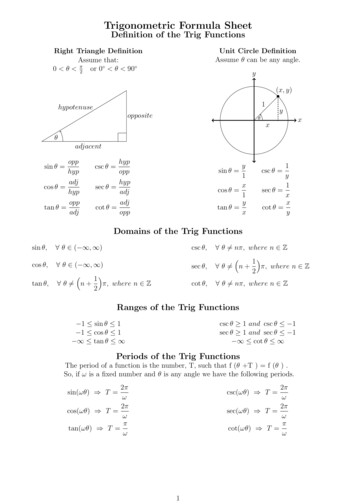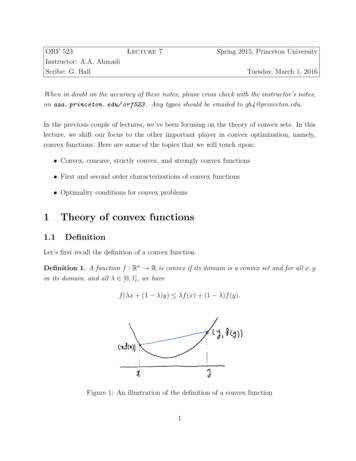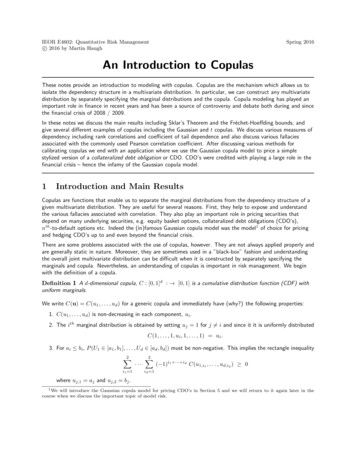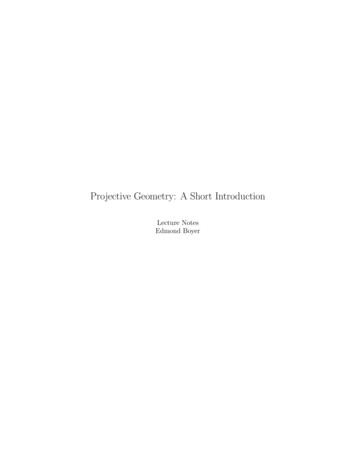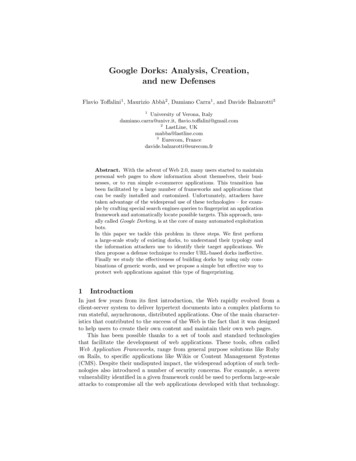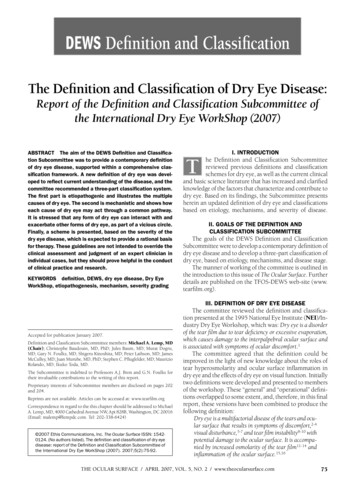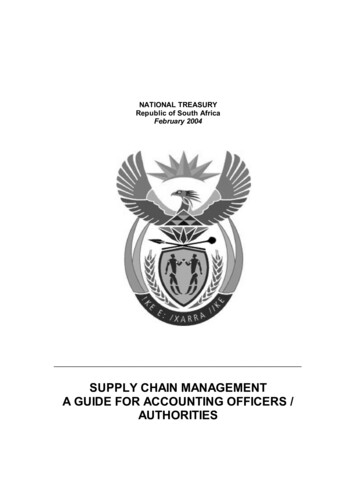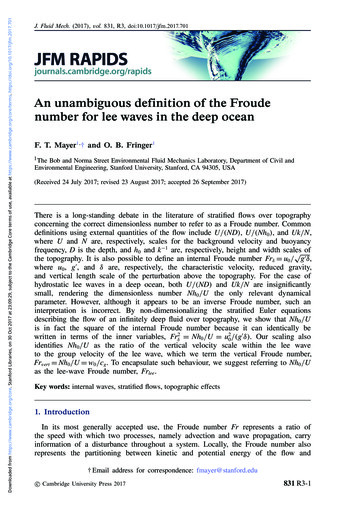
Transcription
Downloaded from https://www.cambridge.org/core. Stanford Libraries, on 30 Oct 2017 at 23:09:29, subject to the Cambridge Core terms of use, available at https://www.cambridge.org/core/terms. https://doi.org/10.1017/jfm.2017.701J. Fluid Mech. (2017), vol. 831, R3, idsAn unambiguous definition of the Froudenumber for lee waves in the deep oceanF. T. Mayer1, † and O. B. Fringer11 The Bob and Norma Street Environmental Fluid Mechanics Laboratory, Department of Civil andEnvironmental Engineering, Stanford University, Stanford, CA 94305, USA(Received 24 July 2017; revised 23 August 2017; accepted 26 September 2017)There is a long-standing debate in the literature of stratified flows over topographyconcerning the correct dimensionless number to refer to as a Froude number. Commondefinitions using external quantities of the flow include U/(ND), U/(Nh0 ), and Uk/N,where U and N are, respectively, scales for the background velocity and buoyancyfrequency, D is the depth, and h0 and k 1 are, respectively, height and width scales ofthe topography. It is also possible to define an internal Froude number Frδ u0 / g0 δ,where u0 , g0 , and δ are, respectively, the characteristic velocity, reduced gravity,and vertical length scale of the perturbation above the topography. For the case ofhydrostatic lee waves in a deep ocean, both U/(ND) and Uk/N are insignificantlysmall, rendering the dimensionless number Nh0 /U the only relevant dynamicalparameter. However, although it appears to be an inverse Froude number, such aninterpretation is incorrect. By non-dimensionalizing the stratified Euler equationsdescribing the flow of an infinitely deep fluid over topography, we show that Nh0 /Uis in fact the square of the internal Froude number because it can identically bewritten in terms of the inner variables, Frδ2 Nh0 /U u20 /(g0 δ). Our scaling alsoidentifies Nh0 /U as the ratio of the vertical velocity scale within the lee waveto the group velocity of the lee wave, which we term the vertical Froude number,Frvert Nh0 /U w0 /cg . To encapsulate such behaviour, we suggest referring to Nh0 /Uas the lee-wave Froude number, Frlee .Key words: internal waves, stratified flows, topographic effects1. IntroductionIn its most generally accepted use, the Froude number Fr represents a ratio ofthe speed with which two processes, namely advection and wave propagation, carryinformation of a disturbance throughout a system. Locally, the Froude number alsorepresents the partitioning between kinetic and potential energy of the flow and† Email address for correspondence: fmayer@stanford.educ Cambridge University Press 2017831 R3-1
Downloaded from https://www.cambridge.org/core. Stanford Libraries, on 30 Oct 2017 at 23:09:29, subject to the Cambridge Core terms of use, available at https://www.cambridge.org/core/terms. https://doi.org/10.1017/jfm.2017.701F. T. Mayer and O. B. FringerUStreamlinesF IGURE 1. Stratified flow over a two-dimensional hill with height h0 , width 2π/k, andupstream flow U and stratification N. Streamlines represent a solution of Long’s equationover a Witch of Agnesi with Uk/N 0.01 and J Nh0 /U 0.5 obtained with theiterative method of Laprise & Peltier (1989b).identifies the flow as sub- or supercritical. For flow over an isolated sill, the criticalvalue of Fr 1 can only occur at the sill crest and indicates that the flow here isunder hydraulic control, meaning that the energetics of the flow are equally partitionedand cannot support any greater volume flux above the obstacle (Armi 1986; Farmer& Armi 1986). In the simple case of inviscid open channel flow in water muchshallower than the horizontal scale of the topography, the Froude number is givenby Fr v/ gd, where v is the local depth-averaged velocity, d is the local depth,and g is the acceleration due to gravity. Upon extension to two flowing layers withdifferent densities,Armi (1986) defines a Froude number for each of i 1, 2 layers as Fri ui / g0 δi , where ui and δi are, respectively, the flow speed and thicknessof layer i, g0 g(1ρ/ρ0 ) is the reduced gravity, and 1ρ is the density differencebetween the two layers. Armi uses these layer Froude numbers to characterize thecriticality of the flow by computing the composite Froude number, G, which, alongwith the Boussinesq approximation and subcritical bulk flow (v/ gd 1, withv (u1 δ1 u2 δ2 )/d and d δ1 δ2 ), is defined as G2 Fr12 Fr22 .In the case of continuously stratified flow over an isolated ridge, the relevantparameters are the ridge height h0 , its width 2π/k, the depth D, and velocity andstratification scales for the unperturbed flow, U and N 2 (g/ρ0 )ρ̄z (see figure 1).Using these parameters, one can form three independent dimensionless numbers thatresemble a Froude number, namely U/(ND), U/(Nh0 ), and Uk/N. However, not allof these numbers represent a ratio of advection to wave propagation speed or relateto the criticality of the flow, and thus referring to all of them as Froude numbers robsthe concept of its intuitive dynamical significance. In his seminal text on stratifiedflow over topography, Baines (1995) proposed that, as a solution to this ‘Froude foreverything syndrome,’ one should only refer to the most obvious extension of openchannel flow as a Froude number. That is, Fr U/(ND), where ND is a scale forthe first-mode (fastest) internal gravity wave speed (which is given exactly by ND/πfrom linear theory with uniform N).For relatively shallow flows over topography, such as tidal flows over a sill in aninlet (Farmer & Smith 1980), U/(ND) is indeed a dynamically significant Froude831 R3-2
Downloaded from https://www.cambridge.org/core. Stanford Libraries, on 30 Oct 2017 at 23:09:29, subject to the Cambridge Core terms of use, available at https://www.cambridge.org/core/terms. https://doi.org/10.1017/jfm.2017.701Lee-wave Froude numbernumber. However, for lee waves generated by abyssal hills at the bottom of theocean, Fr U/(ND) is very small and offers little information about the system. Forexample, in the Drake Passage region of the Antarctic Circumpolar Current (ACC),where abyssal lee waves are predicted to be dynamically important, U 0.1 m s 1 ,N 10 3 rad s 1 , and D 4000 m, giving U/(ND) 0.025 (Nikurashin & Ferrari2010). In these systems, the dynamics are captured elegantly by considering the caseof an infinitely deep ocean, implying U/(ND) 0, for which solutions describe astationary wave above the topography with energy propagating upwards at an angledownstream to infinity (Long 1953).In such deep systems, the relevant dimensionless number is Nh0 /U, which hasvarious names in the literature. Miles (1969) refers to it as the Russell number, Ru,after the fluid mechanician John Scott Russell, who described the reduction in dragon shipping vessels when propelled faster than the shallow water wave speed gd.Aguilar & Sutherland (2006) refer to it as the Long number, Lo, in honour of RobertLong’s pioneering work on the lee-wave problem (Long 1953). Nikurashin & Ferrari(2010) refer to it as a steepness parameter, , after showing that, in the hydrostaticlimit, Nh0 /U is identical to the ratio of the topographic slope to the slope of theinternal wave phase lines, a parameter that the internal tide literature commonly refersto as (Garrett & Kunze 2007). Finally, in much of the literature, Nh0 /U is simplyreferred to either as an inverse Froude number, Fr 1 (Drazin 1961; Kitabayashi 1977;Durran 1986; Kimura & Manins 1988; Smolarkiewicz & Rotunno 1989; Crook, Clark& Moncrieff 1990; Scinocca & Peltier 1994; Legg & Klymak 2008; Eckermann et al.2010; Winters & Armi 2012), or a vertical Froude number, Frz (Peltier & Clark1983; Clark & Peltier 1984; Laprise & Peltier 1989a,c; Afanasyev & Peltier 1998;Welch et al. 2001; Klymak, Legg & Pinkel 2010). However, none of these papersoffer either mathematical or physical justification for their association of Nh0 /U withthe Froude number.Winters & Armi (2012) consider a continuous extension of the layer Froude number,Frδ u0 / g0 δ, where u0 , g0 , and δ are, respectively, the perturbation velocity overthe topography, the reduced gravity arising from the perturbation density, and thecharacteristic vertical scale of the perturbation, and find that Frδ is held at a constantcritical state for flows in which Nh0 /U O(1). Note, however, that the internal Froudenumberdefined by Frδ does not represent a ratio of advection to wave speed, since 0g δ is not the speed of propagation of an internal gravity wave.By non-dimensionalizing the equations describing infinitely deep stratified flow overtopography, the purpose of this paper is to show that, regardless of its name, Nh0 /Uis in fact identical to both the square of the internal Froude number Frδ and a ratio ofthe vertical velocity within the lee wave to the group speed of the wave itself, w0 /cg ,which we refer to as Frvert . The results suggest that it is indeed appropriate to definethe lee-wave Froude number as Frlee Nh0 /U.Additionally, we discuss how our scaling breaks down as Nh0 /U approaches 1,in which case the height of the topography approaches the vertical scale of thelee wave, U/N, and the flow becomes hydraulically controlled, or blocked, withthe internal Froude number held constant at Frδ 1, indicating a saturation of theinternal wave field energetics (Winters & Armi 2012). Thereafter, Nh0 /U informsinstead the magnitude of nonlinear dynamics such as upstream blocking (Smith 1989)or downslope windstorms (Laprise & Peltier 1989a).2. Non-dimensional equationsIn this section we develop a scaling for internal (perturbation) quantities of theflow field in a lee wave based on the characteristic external (background) quantities.831 R3-3
Downloaded from https://www.cambridge.org/core. Stanford Libraries, on 30 Oct 2017 at 23:09:29, subject to the Cambridge Core terms of use, available at https://www.cambridge.org/core/terms. https://doi.org/10.1017/jfm.2017.701F. T. Mayer and O. B. FringerAs discussed in the Introduction, the steady, two-dimensional (in the horizontal x, andvertical z directions) lee wave formed by the flow of a stratified, inviscid fluid over anisolated hill of height h0 and width 2π/k with an infinite depth is characterized by theexternal dimensional quantities U, k, N, and h0 (See figure 1). Rotation is neglectedfor simplicity, and it is assumed that the depth of the domain, D, is irrelevant, i.e.U/(ND) 1.Following Winters & Armi (2012), we separate the flow into its external andinternal quantities such that utotal Uex u0 , ρtotal ρ(z ) ρ 0 , and ptotal ρ0 p(z ) ρ0 p0 , where it is assumed that physical quantities are dimensional,dimensional coordinates are indicated with the , and ex is a unit vector in thex direction. Under these definitions, the governing dimensional equations afteremploying the Boussinesq approximation are given by p0 u0 00 u· u , x x w0 p0ρ0U u0 · w0 g, x zρ020ρ0 N 0 ρw,U u0 · ρ 0 xgU(2.1)(2.2)(2.3)where ex / x ez / z , N 2 g/ρ0 ρ/ z , subject to continuity · u0 0and the dimensional kinematic boundary condition at z h0 (x )U0 h00 h u w0 , x x (2.4)where h0 is the topography as a deviation from a flat bottom.The equations are non-dimensionalized using the inner variable scales defined byu0 u0 u,w0 w0 w,ρ 0 Rρ,p0 Pp,x k 1 x,z δz,(2.5)(2.6)(2.7)(2.8)(2.9)(2.10)where non-primed inner variables and x and z are assumed to be dimensionless. Usingthese scales, non-dimensionalizing the kinematic bottom boundary condition (2.4), andrequiring a balance between the linear terms to leading order implies w0 kh0 U,which gives the non-dimensional kinematic bottom boundary condition h u0 h u w. xU x(2.11)The vertical scale of the flow as indicated by δ is not the same as the hill height h0 ,since δ must be finite as h0 0 (the linear limit). The vertical scale is thus dictatedby continuity, which requires ku0 w0 /δ. Combined with the scaling for the kinematicbottom boundary condition, this implies δ w0 /(ku0 ) kh0 U/(ku0 ) Uh0 /u0 .831 R3-4
Downloaded from https://www.cambridge.org/core. Stanford Libraries, on 30 Oct 2017 at 23:09:29, subject to the Cambridge Core terms of use, available at https://www.cambridge.org/core/terms. https://doi.org/10.1017/jfm.2017.701Lee-wave Froude numberNon-dimensionalizing the x-momentum equation (2.1) givesku0 U p u ku20 u · u kP . x x(2.12)If we require a leading-order balance between the pressure gradient and the linearmomentum advection term, we must have P u0 U, which gives p u u0 u · u . xU x(2.13)In a similar manner, the non-dimensional density transport equation (2.3) is given bykUR ρkρ0 h0 N 2 U ku0 Ru · ρ w, xg(2.14)ρ 0 N 2 h0g(2.15)which impliesR for the linear terms to balance. The non-dimensional density transport equation is thengiven by ρ u0 u · ρ w.(2.16) xUFinally, the non-dimensional vertical momentum equation is given byk 2 h0 U 2 wP p gR k2 h0 Uu0 u · w ρ. xδ zρ0(2.17)If we require a vertical hydrostatic balance to leading order, then we must haveP gR N 2 h0 ,δρ0andP δN 2 h0 which gives 2 N 2 h20 U,u0 w u0 p u · w ρ, xU z(2.18)(2.19)(2.20)whereUk(2.21)Nis the non-hydrostatic parameter and represents a ratio of the frequency with whichthe flow over the hill excites a wave, Uk, to the frequency of the buoyant response,N. A propagating wave is only possible if the excitation frequency is smaller thanthe buoyancy frequency ( 1). Otherwise, the perturbation by the flow over a hilloccurs faster than the buoyancy time scale, giving evanescent behaviour. Within thepropagating regime, one can also think of as a ratio of the vertical wavelength ofthe wave (U/N) to the width of the hill (k 1 ). For wavelengths much smaller than 831 R3-5
Downloaded from https://www.cambridge.org/core. Stanford Libraries, on 30 Oct 2017 at 23:09:29, subject to the Cambridge Core terms of use, available at https://www.cambridge.org/core/terms. https://doi.org/10.1017/jfm.2017.701F. T. Mayer and O. B. Fringerthe hill length ( 1), the wave is approximately hydrostatic and its group velocityis vertically oriented with magnitude cg U (Gill 1982).Returning to the pressure, since the non-dimensional vertical momentum equation(2.20) requires P N 2 h20 U/u0 and the non-dimensional horizontal momentumequation (2.13) requires P u0 U, this implies that u0 Nh0 and thusu0 Nh0 J,UU(2.22)as deduced in Baines (1995), equation (5.2.2). In terms of J, the governingnon-dimensional equations are given by p u Ju · u , x x p w Ju · w ρ, 2 x z ρ Ju · ρ w, x(2.23)(2.24)(2.25)subject to · u 0 and the kinematic bottom boundary condition(1 Ju) h w. x(2.26)These non-dimensional equations imply that the problem is uniquely characterized by and J, and the relevant inner scales (non-dimensionalized by N and U) are givenbyu0 J,Uw0 J,UgR J,ρ0 UNP J,U2δN 1.U(2.27)(2.28)(2.29)(2.30)(2.31)An interesting property of this scaling is that the vertical scale δ, which defines thevertical wavelength of the lee wave 2πδ, is determined exclusively from the upstreamquantities of the flow, U and N, as we expect from linear theory. To test this scaling,we plot the horizontal perturbation velocity normalized by JU for the case shownin figure 1 in figure 2. This figure shows that the maximum perturbation horizontalvelocity is O(JU) and that the vertical wavelength of the lee wave is λ 2πδ.If we now borrow from Winters & Armi (2012) and use the inner scales to definethe internal Froude number as Frδ u0 / g0 δ, where g0 δ g(R/ρ0 )δ JU 2 , this givesFrδ J 1/2 . Therefore, although it appears to represent an inverse Froude number whenexpressed in terms of external variables, this scaling shows that it is in fact appropriateto refer to J Nh0 /U as the square of an internal Froude number because of therelationship between the internal and external variables.831 R3-6
Downloaded from https://www.cambridge.org/core. Stanford Libraries, on 30 Oct 2017 at 23:09:29, subject to the Cambridge Core terms of use, available at https://www.cambridge.org/core/terms. https://doi.org/10.1017/jfm.2017.701Lee-wave Froude ��0.40.4–0.60.2–0.80F IGURE 2. Dimensionless horizontal perturbation velocity, u /(JU) u/J, correspondingto the streamlines plotted in figure 1. The aspect ratio is greatly exaggerated to displayvertical structure. Contours of u 0 are indicated to identify the ‘layers’ of theperturbation and to emphasize that they have a characteristic thickness of πδ.3. DiscussionOur scaling has shown that J Nh0 /U can be interpreted as the square of theinternal Froude number, Frδ , as defined by Winters & Armi (2012). However, thisinterpretation alone is not sufficient to unambiguously define J as a Froude numberbecause it is not readily apparent that Frδ is a ratio of advection to wave speed.Nonetheless, for the special case of the hydrostatic lee wave, our scaling identifiesJ as just such a ratio. Recall that in the hydrostatic limit the group velocity of thewave is oriented vertically with magnitude cg U (Gill 1982). Comparing this wavespeed to the scale for the vertical perturbation velocity, w0 JU, we form the ratiow0 /cg J. Thus, with our scaling J emerges as a Froude number in its most generallyaccepted sense, that is, as a ratio of an advection speed to a wave speed. In this case,it is the ratio of vertical advection speed within the lee wave to the nearly verticalpropagation speed of the lee wave. Such an interpretation justifies reference of J asthe ‘vertical’ Froude number, Frz or Frvert , following Laprise & Peltier (1989a,c).This identification of J as a Froude number derives from a balance of the linearterms in the Euler equations, and is therefore mathematically unjustifiable for leewaves with significant perturbation velocities. Indeed, from the literature it is clearthat the character of the lee wave changes as J approaches O(1). A preconditionon the wave solution to the flow is that it remains stable to both convective andshear instabilities (Long 1953; Miles 1961). Asymptotic and fully nonlinear solutionsfor the streamlines of the flow using Long’s model (Long 1953) show both verticalstreamlines (convective instability) and Richardson numbers smaller than 0.25 (shearinstability) developing when J O(1) for flow over various ridge shapes (e.g. Miles1969; Laprise & Peltier 1989b). Furthermore, laboratory experiments and numericalsimulations demonstrate that in the J 1 regime, the wave field saturates and Jreflects instead the strength of non-wave dynamics such as upstream blocking anddownslope windstorms (Laprise & Peltier 1989a,c; Baines 1995). For this reason, Jis often interpreted as a nonlinearity parameter rather than a Froude number (Miles1969; Baines 1995; Aguilar & Sutherland 2006; Eckermann et al. 2010; Klymaket al. 2010; Nikurashin & Ferrari 2010).831 R3-7
Downloaded from https://www.cambridge.org/core. Stanford Libraries, on 30 Oct 2017 at 23:09:29, subject to the Cambridge Core terms of use, available at https://www.cambridge.org/core/terms. https://doi.org/10.1017/jfm.2017.701F. T. Mayer and O. B. FringerThe upper limit on the valid identification of J as a Froude number is evident whenusing Frδ to devise a physical interpretation of J. As discussed in the Introduction, Frδis the continuous extension of the layer Froude number as defined by Armi (1986),and represents the partitioning of energy within the lee wave between perturbationkinetic energy, u20 , and perturbation potential energy, g0 δ. The scaling u20 JU N 2 h20indicates that the perturbation kinetic energy results from the conversion of thepotential energy of a displaced isopycnal in the wave, N 2 h20 g(R/ρ0 )h0 g0 h0 , intokinetic energy. This conversion takes place within the vertical scale of the lee wave,δ U/N, and thus sets a limit on the maximum possible isopycnal displacement. Inthis sense, we can think of δ as a maximum wave-making capacity; the largest thatu0 can become is when h0 δ, at which point umax Nδ U and the perturbationenergetics are equally partitioned between kinetic and potential energy. As h0 growsbeyond this height, the wave component of the flow will no longer change, as ithas saturated its energetic capacity. Indeed, in their recent study for flow past ahalf-cylinder when J 1, Winters & Armi (2012) show that in this regime, Frδ isheld constant at unity, the energetics of the wave are equally partitioned, and, inanalogy to hydraulic control of a two-layer exchange flow over a sill, the flow ofthe lowest unblocked layer exhibits a transition from subcritical flow upstream to asupercritical jet downstream followed by a dissipative hydraulic jump. Note that thisscaling argument for saturation also confirms that it is inaccurate to identify J asFrvert when J O(1) because we can no longer expect w0 to scale with J in thissupercritical regime.It is thus clear that the relationships we have identified between J, Frvert , andFrδ hold only up to J Nh0 /U O(1). Below this limit, waves accommodate thedisturbance of the hill adiabatically, and carry it away from the site of generation. AsJ approaches O(1), the kinetic component of the wave energetics grows to the samemagnitude as the potential component. All of this is consistent with the dynamicalsignificance of a Froude number, and our scaling thus unambiguously identifies Jwith the Froude number for lee waves in the deep ocean. It is therefore appropriateto simply refer to J as the lee-wave Froude number, Frlee Nh0 /U, noting that Frleeinforms the degree of blocking or other nonlinear processes once Frlee O(1).AcknowledgementWe gratefully acknowledge the support of ONR Grant N00014-16-1-2256 (scientificofficer: Dr T. Paluszkiewicz).ReferencesA FANASYEV, Y. D. & P ELTIER , W. R. 1998 The three-dimensionalization of stratified flow overtwo-dimensional topography. J. Atmos. Sci. 55 (1), 19–39.AGUILAR , D. A. & S UTHERLAND , B. R. 2006 Internal wave generation from rough topography.Phys. Fluids 18 (6), 1–9.A RMI , L. 1986 The hydraulics of two flowing layers with different densities. J. Fluid Mech. 163,27–58.BAINES , P. G. 1995 Topographic Effects in Stratified Flows. Cambridge University Press.C LARK , T. L. & P ELTIER , W. R. 1984 Critical level reflection and the resonant growth of nonlinearmountain waves. J. Atmos. Sci. 41 (21), 3122–3134.C ROOK , N. A., C LARK , T. L. & M ONCRIEFF , M. W. 1990 The Denver cyclone. Part I: generationin low Froude number flow. J. Atmos. Sci. 47 (23), 2725–2742.D RAZIN , P. G. 1961 On the steady flow of a fluid of variable density past an obstacle. Tellus 13(2), 239–251.831 R3-8
Downloaded from https://www.cambridge.org/core. Stanford Libraries, on 30 Oct 2017 at 23:09:29, subject to the Cambridge Core terms of use, available at https://www.cambridge.org/core/terms. https://doi.org/10.1017/jfm.2017.701Lee-wave Froude numberD URRAN , D. R. 1986 Another look at downslope windstorms. Part I: the development of analogsto supercritical flow in an infinitely deep, continuously stratified fluid. J. Atmos. Sci. 43 (21),2527–2543.E CKERMANN , S. D., L INDEMAN , J., B ROUTMAN , D., M A , J. & B OYBEYI , Z. 2010 Momentumfluxes of gravity waves generated by variable Froude number flow over three-dimensionalobstacles. J. Atmos. Sci. 67 (7), 2260–2278.FARMER , D. M. & A RMI , L. 1986 Maximal two-layer exchange over a sill and through thecombination of a sill and contraction with barotropic flow. J. Fluid Mech. 164, 53–76.FARMER , D. M. & S MITH , J. D. 1980 Tidal interaction of stratified flow with a sill in Knight Inlet.Deep-Sea Res. 27, 239–254.G ARRETT, C. & K UNZE , E. 2007 Internal tide generation in the deep ocean. Annu. Rev. Fluid Mech.39, 57–87.G ILL , A. E. 1982 Atmosphere-Ocean Dynamics. Academic Press.K IMURA , F. & M ANINS , P. 1988 Blocking in periodic valleys. Boundary-Layer Meteorol. 44 (1),137–169.K ITABAYASHI , K. 1977 Wind tunnel and field studies of stagnant flow upstream of a ridge. J. Met.Soc. Japan 55 (2), 193–204.K LYMAK , J. M., L EGG , S. M. & P INKEL , R. 2010 High-mode stationary waves in stratified flowover large obstacles. J. Fluid Mech. 644, 321–336.L APRISE , R. & P ELTIER , W. R. 1989a The linear stability of nonlinear mountain waves: implicationsfor the understanding of severe downslope windstorms. J. Atmos. Sci. 46 (4), 545–564.L APRISE , R. & P ELTIER , W. R. 1989b On the structural characteristics of steady finite-amplitudemountain waves over bell-shaped topography. J. Atmos. Sci. 46 (4), 586–595.L APRISE , R. & P ELTIER , W. R. 1989c The structure and energetics of transient eddies in a numericalsimulation of breaking mountain waves. J. Atmos. Sci. 46 (4), 565–585.L EGG , S. & K LYMAK , J. 2008 Internal hydraulic jumps and overturning generated by tidal flow overa tall steep ridge. J. Phys. Oceanogr. 38, 1949–1964.L ONG , R. R. 1953 Some aspects of the flow of stratified fluids I. A theoretical investigation. TellusV, 42–58.M ILES , J. W. 1961 On the stability of heterogeneous shear flows. J. Fluid Mech. 10 (04), 496–508.M ILES , J. W. 1969 Waves and wave drag in stratified flows. In Applied Mechanics. InternationalUnion of Theoretical and Applied Mechanics (ed. W. G. Vincenti & M. Hetnyi), pp. 50–75.Springer.N IKURASHIN , M. & F ERRARI , R. 2010 Radiation and dissipation of internal waves generated bygeostrophic motions impinging on small-scale topography: theory. J. Phys. Oceanogr. 40 (5),1055–1074.P ELTIER , W. R. & C LARK , T. L. 1983 Nonlinear mountain waves in two and three spatial dimensions.Q. J. R. Meteorol. Soc. 109 (461), 527–548.S CINOCCA , J. F. & P ELTIER , W. R. 1994 Finite-amplitude wave-activity diagnostics for Long’sstationary solution. J. Atmos. Sci. 51 (4), 613–622.S MITH , R. B. 1989 Mountain-induced stagnation points in hydrostatic flow. Tellus A 41 (3), 270–274.S MOLARKIEWICZ , P. K. & ROTUNNO , R. 1989 Low Froude number flow past three-dimensionalobstacles. Part I: baroclinically generated Lee vortices. J. Atmos. Sci. 46 (8), 1154–1164.W ELCH , W. T., S MOLARKIEWICZ , P., ROTUNNO , R. & B OVILLE , B. A. 2001 The large-scale effectsof flow over periodic mesoscale topography. J. Atmos. Sci. 58 (12), 1477–1492.W INTERS , K. B. & A RMI , L. 2012 Hydraulic control of continuously stratified flow over an obstacle.J. Fluid Mech. 700, 502–513.831 R3-9
between the two layers. Armi uses these layer Froude numbers to characterize the criticality of the flow by computing the composite Froude number, G, which, along with the Boussinesq approximation and subcritical bulk flow (v p gd 1, with vD.u 1 1 Cu 2 2/ d and d D 1 C 2), is defined as G2 DFr2 1 CFr 2 2.
